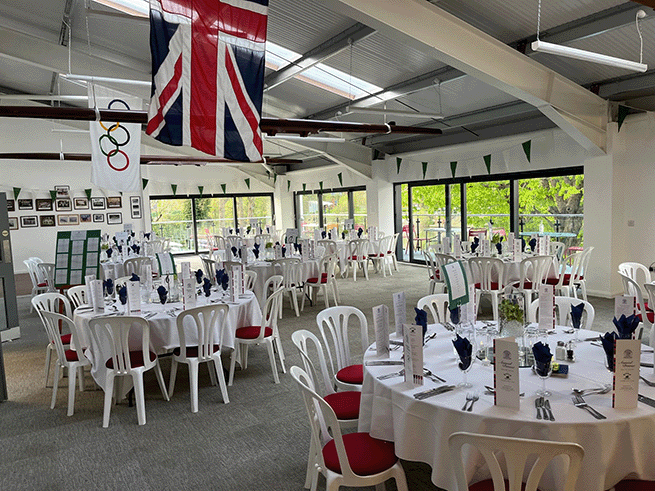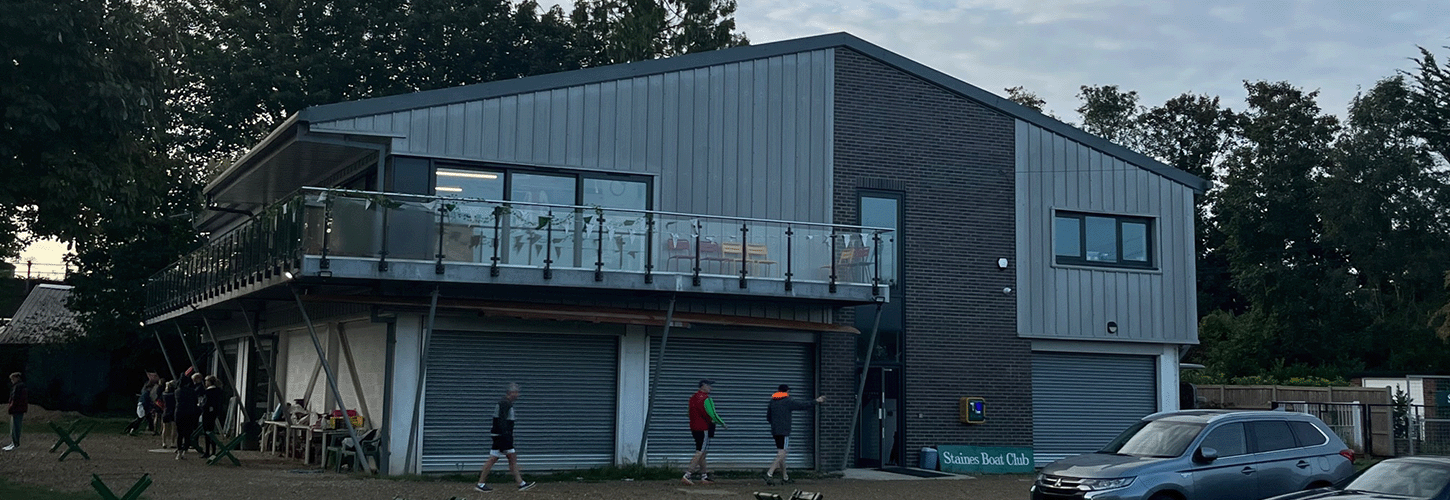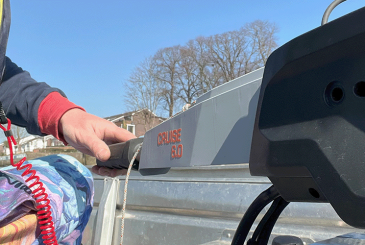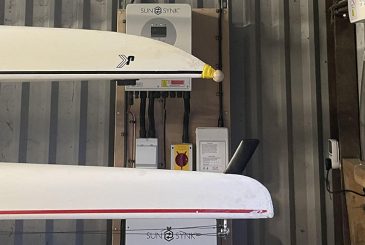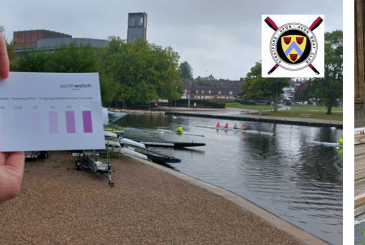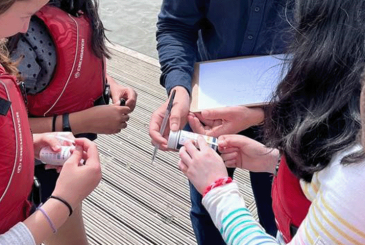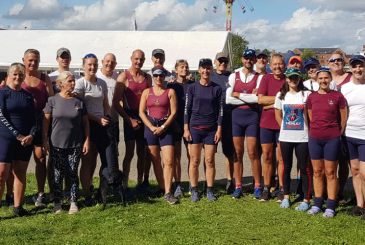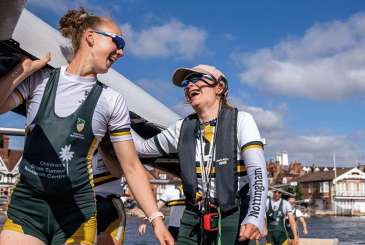Background
Staines BC is a typical, thriving community rowing club, based in the town of Staines-upon-Thames, to the west of London, just inside the M25. It owns the freehold of its site, which includes a members’ car park as well as a spacious grassed area.
Founded 1869, its first boathouse – and its entire fleet of boats – was destroyed by fire in 1950. Through the efforts of members, and with the support of other rowing clubs throughout the country, Staines was able to raise sufficient funds to erect a ‘temporary’ boathouse and buy replacement boats.
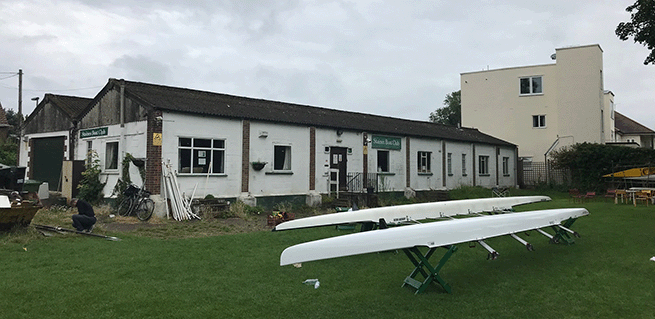
Replacing that ‘temporary’ single-story, concrete prefab boathouse was the subject of numerous discussions from the 1990s onwards. This case study records how the whole club pulled together over the course of a decade – led by the extraordinary efforts of two members – to plan, fund and build the new, permanent clubhouse that opened officially in May 2022.
Deciding what they REALLY wanted and needed
A number of false starts over a period of time helped the club to crystalise its thinking about what it really wanted and needed from the building. Boat bays, changing rooms, a training/clubroom and a bar were clearly essential, but the big question was whether the clubroom should be designed to a specification that would enable it to be hired out as a function room. This could bring in revenue, but the higher spec and extra space necessary would require a bank loan, and much of the revenue would then go into servicing that loan.
The first plans that were drawn together around 2012/13, which included an impressive function room, were costed at about £1m to build. At that time, projects like this were eligible for National Lottery-backed match-funding, so there was optimism that the club ‘only’ needed to raise around £500k. Various fundraising initiatives raised about £150k of this, but the project then lost a certain amount of momentum.
The committee also re-evaluated whether the original plans were the right ones for the club
The project picked up again in 2015 when the club was lucky enough to receive a generous legacy of £250k from a previous Bar Steward who had gone on to found a successful brewery. But by then, £400k was no longer enough, even with match funding, as costs of the approved design had gone up and the planned construction would now have cost £1.5 million to build.
Although the club then identified a potential way of halving the construction cost – by using prefabricated modules – the committee also re-evaluated whether the original plans were the right ones for the club. On reflection, they concluded that they didn’t want the financial responsibility of having to borrow money to build a function room to rent out, which could risk its ownership of the freehold of the land as that would have to be used as security for the loan. They also wanted to avoid the potential risks associated with hosting strangers within the club and disruption to the club’s core activities that this would entail.
With this decision taken, the club had new plans drawn up for the cheapest solution – a basic rectangular box using construction techniques and materials common to industrial or agricultural buildings. As the footprint of this was smaller than that of the original plans, there were no problems in getting planning permission for the revised building.
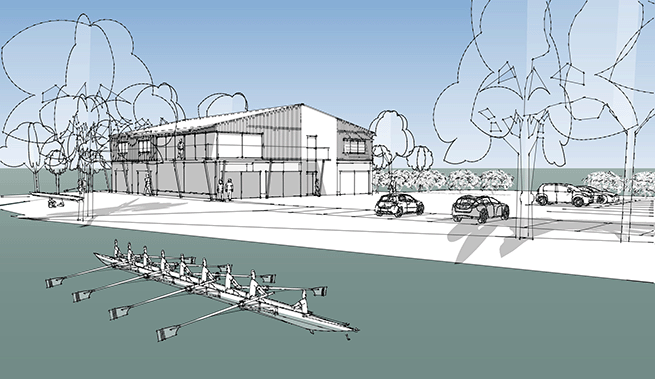
External fundraising
The club then engaged a fundraising consultant to help them raise the additional money they still needed. Club President Alan Douglas says that this was one of the best decisions they made, and would encourage any club in a similar position to consider this investment.
“She had the skills and knowledge to put together successful funding bids and pitches,” he explains. Her value was proven when she secured funding of £110k from the London Marathon Charitable Trust (now the London Marathon Foundation), which had previously turned down a bid that the club had made themselves. Getting this funding was critical because it boosted the up-front capital needed to make a successful bid to Sport England, who granted a further £75k.
An unexpected setback
While all of this fundraising work was going on, the development team, led by Alan, had been progressing the various surveys needed before construction could begin, including ground condition, tree, bat and asbestos surveys on the old building.
By mid-2017, everything was coming together nicely. Then, shortly before the work was about to start work, their chosen main contractor went out of business. Fortunately, the club hadn’t quite signed the contract or paid a deposit, and Alan pays tribute to the contractor’s integrity that they hadn’t tried to squeeze this out of the club to shore up their financial situation.
But although financial disaster was avoided, the club was faced with having to tender again from scratch. To add to the pressure they were under, towards the end of the retendering process the London Marathon Charitable Trust was – quite reasonably – anxious that they start the project as it had committed its funds on the basis that they would be used within a certain timeframe.
Internal fundraising
The club held a ground-breaking ceremony on 6 October 2018, which played an important symbolic role in showing club members that after so many delays, the project really was happening. This was essential because the club didn’t actually have quite enough money in the bank at this point to complete even the shell of the building and they now needed financial support from members.
This was done in three main ways: donations; 10-year interest-free member loans of up to £10k, which brought in about £120k; and lifetime memberships, which raised a further £35k. This money, along with some additional small grants and club social event fundraising activities, covered the main construction costs and a little more.
Keeping the rowing going
The new boathouse was built in what had previously been the car park. This had, in fact, been the location of the original boathouse that burnt down. This meant that the club was in the envious position of being able to continue using the old boathouse until the new one was ready. “We had to put the eights on trestles outside because there wasn’t room to get them out once the site fencing was in place, but that was the only change we had to make to the normal operation of the club” Alan explains.
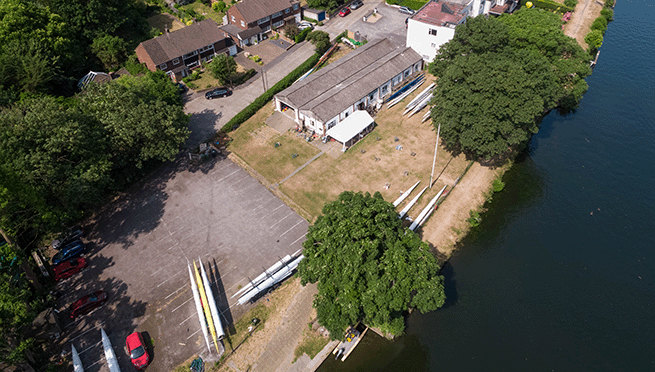
Channelling every available penny of club funds into the build also meant that the club wasn’t able to buy any new boats for over six years, however the fleet was in particularly good condition when the project began thanks to several years of rental income from Sir William Perkins’s School, who had then moved to their own boathouse on the next stretch downriver, as well as from other hosted clubs.
Fitting out
Within nine months, the basic building was complete: But it was very much only a shell with bare concrete floors, outside walls, stairs, doors, windows and a roof plus electricity, water and drains, but very little else. There were no toilets or internal walls upstairs and the stairs were bare concrete with no handrail.
Once again, the challenge helped to highlight an opportunity. “When we went upstairs and saw how high the room was, someone asked whether there was space to add an ergo loft, and that’s exactly what we did,” Alan explains. The steel frame of the building was more than strong enough to take the extra weight.
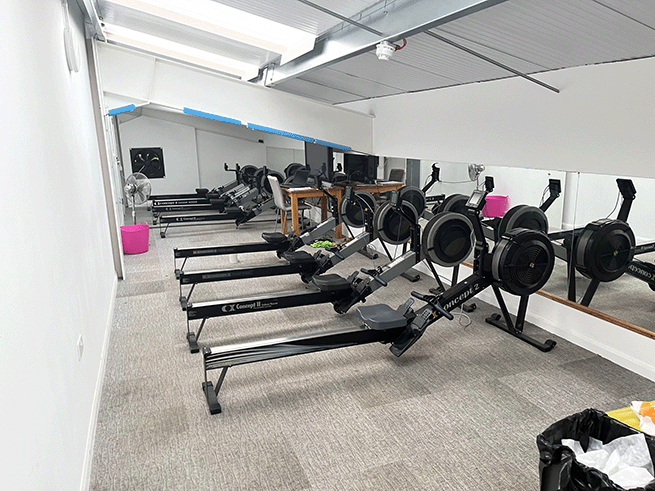
“Every time we raised some more money, we decided what to prioritise.”
The remainder of the fit out is where the club has come together in an extraordinary way. This phase of the work has relied heavily on the expertise of Jeremy Pollen, a club member who was a home developer and therefore had excellent contacts with all the trades, as well as being extremely skilled himself. Skilled members – such as the professional painter and decorator who painted the entire building in a week who took off work, or Tony Rawlings, a rigger maker who fabricated all of the boat racks and painted the bar – were invaluable. So were the generally practical types who worked to Jeremy’s direction, for instance, in laying the pipes for the underfloor heating.
“We filled the shell bit by bit,” Alan recalls. “Every time we raised some more money, we decided what to prioritise.” Club members took on the challenge of procuring fittings for free or at bargain prices. The floor tiles all came from Heathrow for £40 and most of the kitchen and bar were ‘begged’. Some of the work is ongoing; winter 2023-24 will be the first one with warm changing rooms, following the installation of a low carbon air source heat pump, but there still remains some internal fittings to be finished.
Without the generosity of time, skill, effort and funding support from right across the membership in completing the internal fit out it would have taken much longer and cost far more and Alan is immensely grateful to all the membership for their great help in delivering the project.
Moving (boat)house
The club moved into the new boathouse over the course of a busy weekend. “It was a massive, whole-club effort,” says Alan. “There were about 50 people who took everything out of the old place and either cleaned it or put it in the skip. The club then held its first big social event – the Staines Regatta after party – in their spacious new clubroom in July 2021.
The old boathouse was finally demolished in late 2021, enabling the club to get its car park back. This was doubtless much to the relief of its neighbours, who had had to put up with members parking in their streets for nearly three years. In recompense for their patience though, some now have a lovely view of the river instead of a dilapidated old building.
A formal opening ceremony was held on 15 May 2022, which was attended by representatives of the National Lottery, Sport England, British Rowing, the local council and everyone else who had contributed advice, time, effort or money. The building was officially opened by 1980 and 1984 Olympian Chris Mahoney whose sister is a member, and who so inspired him with her explanation of what the club was doing that he made a sizeable donation to the project funds.
Enjoying their new home
The new boathouse, which isn’t quite full, can house eight eights, 20 fours, 18 doubles/pairs and 18 singles with additional singles racks on the outside wall. And although it was designed to be a utilitarian building, the first floor balcony is a popular feature. “It’s the perfect place to have a cup of tea after an outing in the summer,” Alan muses, adding that it also proved to be a glorious space for pre-dinner drinks when Staines hosted 90 people for the annual Remenham Club dinner.
What next?
Although Alan says that he wouldn’t change anything about the design of the building, the club are now considering adding a second small building particularly to use as a weights room. “The underfloor heating upstairs is great because it’s environmentally friendly and it heats the centre of such a large space, which you wouldn’t get with radiators round the walls, but the pipes can crack if you drop a barbell on them, so we can’t really do heavy weights up there,” Alan explains.
Top tips for boathouse rebuilds
- Get in touch with the British Rowing Facilities Service early on.
- Hire a fundraising professional.
- Debate what you really need the building to provide, what you can deliver and what you are prepared to apply for planning permission for.
- Be prepared to phase the build if that’s all your finances will allow, and accept that the entire project will take longer.
- Get the buy-in of members to help deliver the project and make sure they feel part of it with regular updates.
- Identify members who have skills, time or both who can provide ‘work in kind’. Note that the value of work in kind (including the excess over any ‘mates rates’ paid) as well as donated materials can be included in applications for match funding.
- Plan to launch a series of appeals to members and former members. Don’t be afraid to ask for legacies.
- Be creative about keeping the social life of the club going during the build if your facilities are curtailed e.g. with online training sessions.
